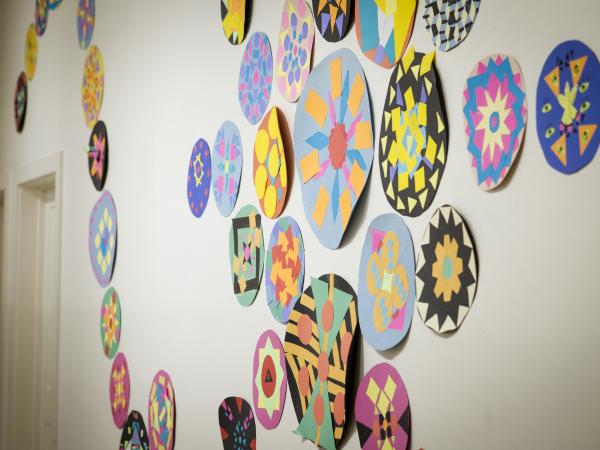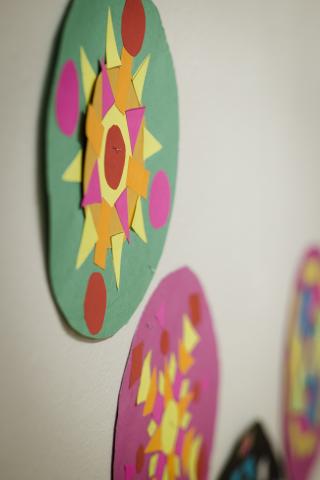Educator Resources
Math Mandalas—Geometry

Students explore geometry concepts through their design and creation of mandalas.
They will use their knowledge of circumference and area to develop a circle which will then become the container for their mandala designs and create their mandala by calculating the area and perimeter of different sized triangles and squares. Key concepts surrounding mandala design will be explored, including pattern, repetition, symmetry, proportion, and shape.
Objectives:
- Students will use formulas for area and circumference of a circle to develop a mandala
- Students will demonstrate understanding of the principles of symmetry, repetition, pattern, and shape through the design of their mandala
- Students will use at least three different sized shapes and calculate the area of each
- Students will choose at least one shape to create two different scales
- Students will write a two-to-three-sentence statement about their use of different formulas to construct their mandala
Basic Lesson Outline:
- Introduce the project
- Show a mandala in progress, explaining how the circle was calculated
- Students begin working on their mandalas
- Students continue working on mandalas
- Students continue and complete mandalas
- Students present and display their mandalas
Art Supplies:
- Poster board (multiple colors)
- Rulers
- Scissors
- Glue
- Pencils
- String
Other Resources:
- Examples of mandalas created
- Slide show to introduce project and related artwork (see outline at the end of the lesson plan)

Idaho State Learning Standards:
Arts and Humanities: Anchor Standard 4: Convey meaning through the presentation/performance/production of an original work or unique interpretation of a work
- Objective PR1.1 Combine knowledge and understanding from two or more disciplines to present/perform their original or interpreted works for an audience
- Objective PR1.2 Convey meaning through their presentation/performance
CCSS.MATH.CONTENT.7.G.A.1
Solve problems involving scale drawings of geometric figures, including computing actual lengths and areas from a scale drawing and reproducing a scale drawing at a different scale.
CCSS.MATH.CONTENT.7.G.B.4
Know the formulas for the area and circumference of a circle and use them to solve problems; give an informal derivation of the relationship between the circumference and area of a circle.
CCSS.MATH.CONTENT.7.G.B.6
Solve real-world and mathematical problems involving area, volume and surface area of two- and three-dimensional objects composed of triangles, quadrilaterals, polygons, cubes, and right prisms.
Academic Language:
- Subject area language: circumference, area, diameter, radius, and perimeter
- Art language: mandala, symmetry, repetition, pattern, shape, and mindfulness
Student Use of Vocabulary:
Students will use the words when creating their projects, when writing about their projects, and when discussing their projects
Student Grouping:
Students will work independently
Day 1 – Introduction
Introduce the project with a slide show
Show art reflecting a relationship between math and art, and ask:
- What do you see?
- Why do you think the artists did that?
- How do you think the artist did that?
- How can you see math used in the art?
Discuss mandalas
- What are they?
- Where did they come from?
- Why make them?
Introduce expectations and formulas
Discuss goals: art and educational
Show the beginnings of a mandala
Day 2 – Artmaking
- Demonstrate use of determining size, circumference, and surface area in creating a mandala
- Give students the remainder of the class to calculate their mandala size, circumference, and surface area
Day 3 – Artmaking
Introduce incorporating shapes and designs into the mandala
- Explain how to calculate the surface area of a triangle and a square
- Demonstrate repetition, balance, and pattern
Students will begin designing their mandalas using three different shapes
Day 4 – Artmaking
- Students will continue to work on their designs.
- Students will title their work and write an artist statement
Day 5 – Presentations
- Students will assist in the display of their artwork
- Students write their artist statement about their artwork if they have not already
Slide examples:
Wearable art and geometric art
- Introduce project
- Encourage students to share what they see in the slide show: there are no wrong answers
Leonardo Da Vinci’s drawings
- Mathematician, inventor, and artist
- Measurements of the Canon of Beauty
M.C. Escher
- How does Escher use math in his drawings?
- Shapes
- Measuring
Jay Nelson’s “Golden Gate” vehicle
- How does this artist use math?
- Measurements
- Angles
Design first, and then build
- Paige Smith’s “Urban Geode Project”
- What geometric shapes do you see here?
- 3D triangle = pyramid
- Your artwork needs to hold itself together
Nick Cave’s “Soundsuits”
- How does this artist use math?
- How does this artist make his art wearable?
Phil Ferguson
- From Australia; made wearable sculptures to see how many friends he could make on Instagram
- How does he use math?
Nora Fok
- She makes wearable sculptures
- Students will focus their project on a specific body part
Head Pieces
- Makotoyabuki.com, Hector Sos, Tracey Featherstone, Fred Butler (including picture of Lady Gaga)
Neck Pieces
- Tatiana Inglis, Suo Emiko, Bin Dixon-Ward, Sarah West
Examples of open form and closed forms
- Closed forms look heavier, open forms look lighter
Shoulder and Chest Pieces
- Tine De Ruysser, Tracey Featherstone, Dominique Thomas Vansteenberghe, Mashallah Design
Back Pieces
- Tracey Featherstone, Birgit Toke Tauka Frietman
Arm, Hand and Finger Pieces
- Bin Dixon-Ward, Hande Akcayli, Murat Kpcyigit and Linda Kostowski, Tracey Featherstone, Bryan Cera

0 comments
Leave a Comment